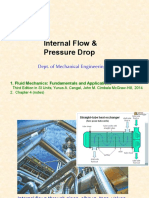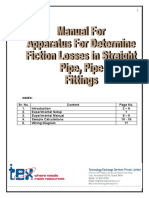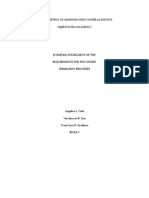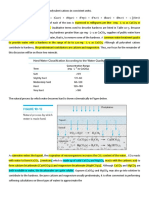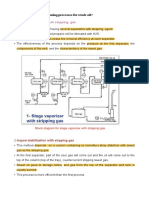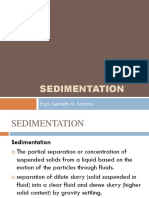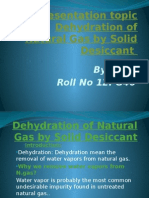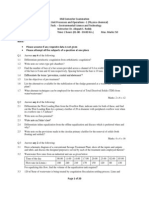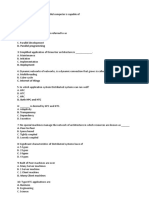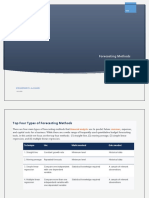Fluid Properties: Dr. Akepati S. Reddy Thapar University Patiala (PUNJAB) - 147 004 India
Fluid Properties: Dr. Akepati S. Reddy Thapar University Patiala (PUNJAB) - 147 004 India
Uploaded by
Dr. Akepati Sivarami ReddyCopyright:
Fluid Properties: Dr. Akepati S. Reddy Thapar University Patiala (PUNJAB) - 147 004 India
Fluid Properties: Dr. Akepati S. Reddy Thapar University Patiala (PUNJAB) - 147 004 India
Uploaded by
Dr. Akepati Sivarami ReddyOriginal Title
Copyright
Share this document
Did you find this document useful?
Is this content inappropriate?
Copyright:
Fluid Properties: Dr. Akepati S. Reddy Thapar University Patiala (PUNJAB) - 147 004 India
Fluid Properties: Dr. Akepati S. Reddy Thapar University Patiala (PUNJAB) - 147 004 India
Uploaded by
Dr. Akepati Sivarami ReddyCopyright:
Fluid Properties
Dr. Akepati S. Reddy
Thapar University
Patiala (PUNJAB) 147 004
INDIA
Primary Dimensions and Units Secondary Dimensions
Other basic dimensions
Amount of substance
Electrical current
Luminous intensity
Plane angle
Solid angle
Dimensions and units
Multiplying factors
and their prefixes and symbols
Fluids (Liquids and Gases)
Solids and fluids
Solids resist shear forces
Fluids undergo continuous deformation due to shear forces fluids
flow
Liquids and gases
Liquids are denser and have some order in the molecular structure
very less intermolecular distance (<10-8 m) molecular movement is
quite small (only vibration)
Gases have quite large intermolecular distance intermolecular forces
are very small and moleculaes move randomly and colloide
Critical temperature and pressure
The maximum temperature at which a gas can be liquified through
application of pressure is critical temperature and the pressure
needed is critical pressure - Critical temp. and pressure for
CO2 are 31.1C and 75 atmos.
Ammonia are 132C and 111.5 atmos.
Water are 374C and 217.7 atmos.
Continuum and Fluid Properties
Continuum: Disregarding the wide spacing of molecules, gas is
viewed as a continuous (homogeneous) matter with no holes.
Continuum is valid as long as size of the system is large in comparison
to distance between molecules.
Continuum allows treatment of fluid properties as smoothly varying
Fluid properties
Intensive properties: Properties independent of mass of the system -
temperature, pressure, and density.
Extensive properties: Properties that depends on the size or mass of
the system - Total mass, total volume, and total momentum
Specific properties: Extensive properties per unit mass - specific
volume and specific total energy
Kinematic Properties: Linear velocity, angular velocity, vorticity,
acceleration, strain rate
Transport Properties: Viscosity, thermal conductivity, mass diffusivity
Thermodynamic Properties: Pressure , density, temperature, enthalpy,
entropy, bulk modulus, coefficient of thermal expansion
Other miscellaneous properties: Surface tension, vapour pressure,
eddy-diffusion coefficients
Density, Specific Gravity and Equation of State
Defined as mass per unit volume ( = m/V) Units: kg/m
3
Specific volume: v = 1/ = V/m. Inverse of density
For a gas, density depends on temperature and pressure
Specific gravity (relative density): the ratio of density of a
substance to the density of some standard substance (usually
water at 4C)
SG=/
H
2
0
dimensionless quantity
specific weight (weight density): weight per unit volume
s
= g where g is gravitational acceleration Units for
s
: N/m
3
Equation of State (equation for relationship between pressure,
temperature, and density) or ideal-gas equation:
P v = R T or P = R T Holds for most gases
At low pressures and high temperatures, the density of a gas decreases,
and the gas behaves as an ideal gas under these conditions
However, dense gases such as water vapor and refrigerant vapor should
not be treated as ideal gases
How does fluid volume change with P and T ?
Fluids expand as T or P
Fluids contract as T or P
The amount of volume change is different for different fluids
T
T
P P
v
v
k
| | c c
| |
= =
| |
c c
\ .
\ .
1 1
P P
v
v T T
c c
| | | |
= =
| |
c c
\ . \ .
P T
v v
dv dT dP
T P
c c
| | | |
= +
| |
c c
\ . \ .
Coefficient of compressibility
Coefficient of volume expansion
Combined effects of P and T
Relating volume changes to changes in P and T
( )v dP k dT = |
Coefficient of Compressibility
Also called as bulk modulus of compressibility or bulk modulus
of elasticity
Fluids act like elastic solids with respect to pressure.
A larger value of k indicates that a large change in pressure is
required to cause very small change in volume - fluid with a
large k is essentially incompressible
coefficient of compressibility of an ideal gas k
ideal gas
= P (Pa)
T
T
P P
v
v
k
| | c c
| |
= =
| |
c c
\ .
\ .
Isothermal Compressibility: inverse of the coefficient of
compressibility - represents the fractional change in volume or
density corresponding to a unit change in pressure
|
.
|
\
|
c
c
=
|
.
|
\
|
c
c
= = o
P
1
P
v
v
1
k
1
T
Coefficient of Volume Expansion
The density of fluid depends more on temperature - variation of
density with temperature is responsible for rise of plumes in
chimney, use of ventilators in room, operation of hot air balloons,
heat transfer by natural convection, etc.
Coefficient of volume expansion:
A large value of | for a fluid means a large change in density with
temperature
P P
T
1
T
v
v
1
|
.
|
\
|
c
c
=
|
.
|
\
|
c
c
= |
) T T (
T T
/ ) (
| =
= |
Natural convection is initiated by the buoyancy force, which is
proportion to the density difference, which is proportional to
temperature difference at constant pressure.
Volume expansion coefficient of an ideal gas
) K / 1 (
T
1
gas ideal
= |
Energy and Specific Heats
Total energy E is comprised of thermal, mechanical, kinetic,
potential, electrical, magnetic, chemical, and nuclear
Units of energy: joule (J)
Microscopic energy
Internal energy u is for a non-flowing fluid and is due to
molecular activity.
Enthalpy for a flowing fluid: h=u+Pv Pv: flow energy
Macroscopic energy
Kinetic energy ke=V
2
/2
Potential energy pe=gz
In the absence of electrical, magnetic, chemical, and nuclear
energy, the total energy is e
flowing
=h+V
2
/2+gz.
Vapour Pressure
Molecules escape and re-enter a liquid/water that is in
contact with atmosphere/air/gas
Partial pressure: Pressure of a gas/vapour P
p
in a mixture with
other gases
P
p
of vapour
< P
v
when no liquid is in contact
P
p
of vapour
= P
v
when the liquid is in contact
P
v
= vapour or saturation pressure
Vapour pressure of water at 20C is 2.34 kN/m
2
while
atmospheric pressure is 101.0 kN/m
2
Vapor Pressure (P
v
): pressure exerted by its vapor in phase
equilibrium with its liquid at a given temperature
If the pressure is below the vapour pressure net escape of
molecules from liquid to gas occurs
At this pressure a dynamic equilibrium exists between the
escaping and re-entering molecules
Vapour Pressure
When heated to a temperature at which the vapour pressure
equals atmospheric pressure, liquids boils
Increasing atmospheric pressure increases liquid boiling point
If pressure of the gas in contact with liquid is reduced to vapour
pressure then vaporation of the liquid occurs
If P drops below P
v
, liquid is locally vaporized and cavities of
vapor are created the vapor cavities collapse when local P
rises above P
v
(cavitation) and create problems
Cavitation, since it reduces performance, generates annoying
vibrations and noise and causes damage to equipment, must be
avoided in flow systems
When the liquid flows through valves, elbows, turbine blades,
etc., pressure can drop to sufficiently low value (a cause of
cavitation problem)
Large number of bubbles collapsing near the solid surface over a
long period of time may cause erosion, surface pitting, fatigue
failure and destruction of components or machinery.
The presence of cavitation in a flow system can be sensed by its
characteristic tumbling sound
Viscosity
Internal stickiness of a fluid is viscosity - Internal resistance for flow
The viscosity of a fluid is directly related to the pumping power
needed to transport a fluid in pipe or to move a body through a fluid
Magnitude of the drag force (force exerted by flowing fluid on a body in
the flow direction) depends, in part, on viscosity
Viscosity is related to velocity through shear stress
Consider fluid between two very large
parallel plates separated by a distance l
Shear stress t = F/A. Units: N/m
2
For no-slip condition
u(0) = 0 and u(l) = V
Velocity profile and gradient are
du/dy=V/l
dy
du
t =
is shear stress (N/m
2
)
is viscosity (Poise or N.s/m
2
)
du/dy is velocity gradient
u is velocity and y is flow depth/thickness
Viscosity
Viscosity (also called dynamic viscosity, absolute viscosity or
coefficient of viscosity)
= t (du/dy) = v v is kinematic viscosity
Units: Ns/m
2
or poise ( Poise = 0.1 Ns/m
2
)
Kinematic viscosity (units: m
2
/sec.)
Units: m
2
/s or Stoke (1 Stoke = 1 cm
2
/s = 10
-4
m
2
/s)
In gases it depends both on temperature and pressure (density
of a gas is function of both temperature and pressure)
( )
( )
( )
v
density
ity vis dynamic
viscoisity Kinematic
cos
=
Viscosity and temperature
Viscosity depends on temperature for liquids decreases with
increasing temperature and for gases increases with increasing
temperature in liquids viscosity is due to cohesive forces and in
gases it is due to collisions of molecules
For gases, temperature influence on viscosity can be approximated
by either power law or Sutherland law:
For liquids, influence of temperature on viscosity can be shown
by the following empirical expression:
Viscosity Types of Fluids
Newtonian fluids and non-Newtonian fluids
Fluids that exhibit linear relationship between shear stress and
velocity gradient are Newtonian fluids
Many common fluids (air, water and oils) are Newtonian fluids
Dilatants, pseudoplastics and ideal plastics are non-Newtonian fluids
(rheological fluids)
Viscosity types of fluids
Dilatant, or shear-thickening fluid increases resistance with
increasing applied stress (solutions of suspended starch and
sand)
Pseudoplastic, or shear-thinning fluid decreases resistance with
increasing stress (paints , polymer solutions)
If the thinning effect is very strong, the fluid is termed plastic. The
limiting case of a plastic is a finite yield stress before it begins to flow
Bingham plastic: requires yield stress before it begins to flow
and flow behaviour after the yield is nonlinear (toothpaste)
Rheopectic fluids: require a
gradually increasing shear stress
to maintain a constant strain
rate
Thixotropic fluids: these thin out
with time and require
decreasing stress to maintain a
constant strain rate
Viscosity measurement and viscometer
A long cylinder rotating at angular speed inside a static
(zero velocity) second cylinder by an applied torque of T
Radius of the inner cylinder is R and its surface velocity is R
Gap between the two cylinders is h and velocity distribution in
this gap is essentially linear
Shear stress in the above case can be related with the applied
toque as follows:
L R
h T
h
L R
R RL
h
R
T
arm Moment Area stress Shear Torque
h
R
O
=
O
=
O
=
=
O
=
3
3
2
2 2
t
t t
t
Here L is length of the cylinder
Here the shear acting on the ends of the long cylinders has been neglected
R is radius of the rotating cylinder
is angular velocity
h is gap between the static outer cylinder and
rotating inner cylinder
Fluid sheared between two long cylinders
Bulk modulus
Bulk modulus (has same units as pressure)
2100 Mpa is the bulk modulus of water at 20C
Water needs 21000 kPa pressure for changing the volume by 1%
Bulk modulus of water is used for determining speed of sound in liquid
B
c =
B is bulk modulus
Speed of sound in water is 1450 m/sec. at 20C
Surface Tension
Liquid droplets behave like small spherical balloons filled with liquid
and the liquid surface like a stretched membrane under tension
This tension is due to cohesive forces between the fluid molecules
and acts parallel to the surface
Forces from interior molecules cause the liquid to minimize its
surface area and attain spherical shape
Magnitude of this force per unit length is called surface tension
(also called surface energy) Units: os (N/m)
droplets to form, and small droplets and bubbles to be spherical all
are due to surface tension
Surface tension varies from substance to substance
Presence of impurities reduce surface tension (can be reduced by
adding surfactants, detergents!)
Surface tension decreases with increase in temperature and
becomes zero at the critical temperature point
Effect of pressure on surface tension is negligible
Surface Tension: pressure inside a liquid
droplet/air bubble
r
P
is inside pressure bubble a For
r
P
r r P
droplet the inside f orce pressure tension surf ace to due f orce
o
o
o t t
4
2
2
2
=
=
=
=
Here
r is droplet/bubble radius
is surface tension
P is inside pressure
Water drop Air Bubble
For a spherical droplet
pressure force inside the
droplet balances the force
due to surface tension
around the bubble
circumference
For a bubble there are two
surfaces and hence the
surface tension force is
double to that of a droplet
Surface Tension: Capillary Rise
Surface tension causes rise of liquid in a
capillary tube
Weight of the raised column of the liquid is
balanced by the surface tension force
Weight of the raised liquid column
Surface tension force
Capillary rise
D
Cos
h
Cos D f orce tension surf ace
h
D
g W
| o
| t o
t
4
4
2
=
=
=
g =
Here
A liquid is said to wet the surface if | < 90
o
and not to wet the surface when | > 90
o
The strength of capillary effect is quantified
by contact angle (the angle that the
tangent to the liquid surface makes with
solid surface at the point of contact)
Capillary rise/drop h = 2oscos | / gR
Capillary Effect
Capillary effect is the rise or fall of a liquid in a
small-diameter tube.
The curved free surface in the tube is called the
meniscus.
Water meniscus curves up because water is a
wetting fluid.
Mercury meniscus curves down because
mercury is a non-wetting
Force balance can describe magnitude of
capillary rise.
P
gage
=P
abs
- P
atm
P
vac
=P
atm
- P
abs
Absolute, gauge, and vacuum pressures
Actual pressure at a give point is called the absolute pressure.
Pressure-measuring devices are usually calibrated to read zero in the atmosphere
Pressure above atmospheric pressure is called gage pressure and pressure below
atmospheric pressure is called vacuum pressure
Pressure at a Point
Compressive force exerted per unit area
Units: N/m
2
, (called a Pascal, Pa) - Other units used: bar, atm,
kgf/cm
2
, lbf/in
2
=psi.
Pa is too small for pressures encountered in practice, hence kPa
and Mpa are commonly used
Pressure at any point in a fluid is the same in all directions
(Pascals Law) (P
x
=P
y
=P
z
)
Pressure has magnitude, but no direction, and hence it is a
scalar quantity
Pressure increases with depth (more fluid rests on deeper
layers)
Points a, b, c, and d are at equal depths
in water and therefore have identical
pressures.
Point D has different pressure from A, B,
and C because it is not connected to
them by a water path
1 2 2 2
1 2
1 2 1 1
F F F A
P P
A A F A
= = =
Ratio A2/A1 is the ideal mechanical advantage
Pressure changes through a
column of fluids & multiple fluids
Manometry: Pressure
measuring devices based on
liquid columns in vertical or
inclined tubes
Piezometer Tube
U-Tube Manometer
Differential U-Tube Manometer
Can be used to measure small pressure differences accurately
Inclined-Tube Manometer
C atm
atm
P gh P
P gh
+ =
=
The Barometer
Atmospheric pressure is often referred to as barometric
pressure.
P
C
can be taken as zero (only Hg vapor is above point C,
and pressure exerted by it is negligible)
You might also like
- Center of Mass N Rigidity Lecture-Sample Problem1Document5 pagesCenter of Mass N Rigidity Lecture-Sample Problem1Francis CabinganNo ratings yet
- Material and Energy BalanceDocument23 pagesMaterial and Energy BalanceSaurabh KumarNo ratings yet
- Mass TransferDocument3 pagesMass TransferAbdul QayyumNo ratings yet
- Water Treatment QuizDocument3 pagesWater Treatment QuizDr. Akepati Sivarami Reddy100% (5)
- Water Flow in Pipes: The Islamic University of Gaza Faculty of Engineering Civil Engineering DepartmentDocument111 pagesWater Flow in Pipes: The Islamic University of Gaza Faculty of Engineering Civil Engineering DepartmentZami FurqonNo ratings yet
- Climbing Film Evaporation Data (2016) - All GroupsDocument12 pagesClimbing Film Evaporation Data (2016) - All GroupsJuwon Jeremiah MakuNo ratings yet
- ERT 313 Bioseparation Engineering Gas Absorption: Prepared By: Pn. Hairul Nazirah Abdul HalimDocument57 pagesERT 313 Bioseparation Engineering Gas Absorption: Prepared By: Pn. Hairul Nazirah Abdul HalimVenkateswara RamakrishnanNo ratings yet
- Classification of FluidDocument29 pagesClassification of FluidAbdur RehmanNo ratings yet
- Pumps and Water/wastewater PumpingDocument59 pagesPumps and Water/wastewater PumpingDr. Akepati Sivarami Reddy100% (3)
- Venturi MeterDocument27 pagesVenturi MeterChristopher GarciaNo ratings yet
- Environmental Engineering Lecture 3Document14 pagesEnvironmental Engineering Lecture 3Greco AlindoganNo ratings yet
- Gas AbsorptionDocument34 pagesGas Absorptionlickaa200100% (1)
- All ProblemsDocument29 pagesAll Problemsahmed hatemNo ratings yet
- Liquid Liquid ExtractionDocument25 pagesLiquid Liquid ExtractionsyafiqNo ratings yet
- SedimentationDocument8 pagesSedimentationAnkush AgarwalNo ratings yet
- Pressure DropDocument54 pagesPressure DropAbu Abdullah AlkaffNo ratings yet
- (W .622 (P /P - P) ) : Air Conditioning and VentilationDocument6 pages(W .622 (P /P - P) ) : Air Conditioning and Ventilationrichelle camachoNo ratings yet
- Liquid Liquid Equilibrium Study of The Water + Acetic Acid + Kerosene Ternary System at 293.2, 298.2, and 308.2 KDocument10 pagesLiquid Liquid Equilibrium Study of The Water + Acetic Acid + Kerosene Ternary System at 293.2, 298.2, and 308.2 KMagesh kumarNo ratings yet
- Module 1: Introduction To Heat TransferDocument168 pagesModule 1: Introduction To Heat TransferMohit MittalNo ratings yet
- Mixed Bed Resin Loading ProcedureDocument2 pagesMixed Bed Resin Loading ProcedurePramudito Aji WicaksonoNo ratings yet
- Apparatus For Friction Losses in Pipe Fittings ManualDocument17 pagesApparatus For Friction Losses in Pipe Fittings ManualShoaib PathanNo ratings yet
- Gas Absorption ManualDocument13 pagesGas Absorption ManualKiann Domingo100% (1)
- Treatment of Water & WastewaterDocument40 pagesTreatment of Water & WastewaterAli RazaNo ratings yet
- Membrane 1Document41 pagesMembrane 1Abhishek GadhwalNo ratings yet
- Che Lab 1 (Gas Ab/Adsorption) : Engr. Mary Jane C. Calagui Che Department CsuDocument18 pagesChe Lab 1 (Gas Ab/Adsorption) : Engr. Mary Jane C. Calagui Che Department CsuEmmanuel JimenezNo ratings yet
- Flow Through PipesDocument9 pagesFlow Through Pipesatif irshadNo ratings yet
- Sand FiltrationDocument28 pagesSand FiltrationAnonymous bHh1L1No ratings yet
- Week # 10 MR Chapter 8: - Tutorial #10Document31 pagesWeek # 10 MR Chapter 8: - Tutorial #10Farras HanifNo ratings yet
- Design of Gas Absorber For The Exhaust Gases of Ammonia PlantDocument11 pagesDesign of Gas Absorber For The Exhaust Gases of Ammonia PlantVan Lim100% (1)
- Chemical CharacteristicsDocument12 pagesChemical CharacteristicsDiana BunaganNo ratings yet
- Experiment No.1 Flow Through Pipes Background and TheoryDocument8 pagesExperiment No.1 Flow Through Pipes Background and TheoryMradul YadavNo ratings yet
- MembranesDocument30 pagesMembranesInamullah MaitloNo ratings yet
- Sedimentation 2Document14 pagesSedimentation 2Habib AbdullahNo ratings yet
- Heat and Mass Transfer in Impingement DryingDocument31 pagesHeat and Mass Transfer in Impingement DryingEKKACHAI PRABNAKORNNo ratings yet
- Weeping ConditionsDocument4 pagesWeeping ConditionsJaldhi PatelNo ratings yet
- Auxiliary VesselDocument3 pagesAuxiliary VesselSachin5586No ratings yet
- Sedimentation Tank DesignDocument12 pagesSedimentation Tank DesignbkkbrazilNo ratings yet
- Wet ScrubbersDocument30 pagesWet ScrubbersMelvin DapitanonNo ratings yet
- Properties of Fluids by S K MondalDocument30 pagesProperties of Fluids by S K MondalLokesh DahiyaNo ratings yet
- Equipment Design - Precipitation Tank 2Document12 pagesEquipment Design - Precipitation Tank 2Aldous Tabuzo100% (1)
- Mist EliminatorDocument4 pagesMist Eliminatorherysyam1980No ratings yet
- Flow EqualizationDocument9 pagesFlow EqualizationhaymedeleonNo ratings yet
- Charter of ECRADocument13 pagesCharter of ECRAMahmood MuftiNo ratings yet
- Topic 0 DryingDocument43 pagesTopic 0 DryingJA NableNo ratings yet
- Nano FluidDocument23 pagesNano FluidPrashant PatelNo ratings yet
- Assessment of Venturi Nozzle For Filter Bag Cleaning in PDFDocument0 pagesAssessment of Venturi Nozzle For Filter Bag Cleaning in PDFUmanath R PoojaryNo ratings yet
- (Chen-1104) Particulate Technology: Lecture 10 - NumericalsDocument32 pages(Chen-1104) Particulate Technology: Lecture 10 - NumericalsMalik DaniyalNo ratings yet
- 11 Momentum TransferDocument10 pages11 Momentum TransferJohn Bryan AldovinoNo ratings yet
- Edexcel Higher Fluid Mechanics H1 Unit 8 NQF Level 4 Outcome 2 Viscosity Tutorial 2 - The Viscous Nature of FluidsDocument10 pagesEdexcel Higher Fluid Mechanics H1 Unit 8 NQF Level 4 Outcome 2 Viscosity Tutorial 2 - The Viscous Nature of FluidsTejas PatelNo ratings yet
- Hydrodynamics of Packed ColomnDocument6 pagesHydrodynamics of Packed ColomnDhananjay KadamNo ratings yet
- Sweetening ProcessDocument3 pagesSweetening Processمرتضى حامد كاظم رحيمNo ratings yet
- Critical VelocityDocument35 pagesCritical Velocitykalimullah_km0% (1)
- SEDIMENTATION PresentationDocument45 pagesSEDIMENTATION PresentationShai Sta CatalinaNo ratings yet
- Dehydration of Natural Gas by Solid DesiccantDocument20 pagesDehydration of Natural Gas by Solid DesiccantMadhankumar LakshmipathyNo ratings yet
- Fluid FlowDocument28 pagesFluid FlowTiotet33No ratings yet
- Particle ReviewerDocument7 pagesParticle ReviewermarneljollyfranciscoNo ratings yet
- Have A Working Knowledge of The Basic PropertiesDocument24 pagesHave A Working Knowledge of The Basic PropertiesgizemtasNo ratings yet
- ME 4411 - 02-Properties of FluidDocument37 pagesME 4411 - 02-Properties of FluidgmostafeezNo ratings yet
- Chapter 1 - Physical Properties of LiquidDocument21 pagesChapter 1 - Physical Properties of LiquidGSaurav DahalNo ratings yet
- EC ThaparDocument8 pagesEC ThaparDr. Akepati Sivarami ReddyNo ratings yet
- Solar PV CourseDocument126 pagesSolar PV CourseDr. Akepati Sivarami Reddy100% (3)
- Sewer AppurtanancesDocument56 pagesSewer AppurtanancesDr. Akepati Sivarami Reddy100% (4)
- Sewerage and Sewage Treatment - Tutorials 1 To 8Document13 pagesSewerage and Sewage Treatment - Tutorials 1 To 8Dr. Akepati Sivarami Reddy0% (1)
- IEE EnMS Practical Guide PDFDocument78 pagesIEE EnMS Practical Guide PDFDr. Akepati Sivarami ReddyNo ratings yet
- Sewage Treatment OverviewDocument13 pagesSewage Treatment OverviewDr. Akepati Sivarami Reddy100% (3)
- Sewerage and Sewage Treatment - 2014 - Solutions For End Semester ExaminationDocument16 pagesSewerage and Sewage Treatment - 2014 - Solutions For End Semester ExaminationDr. Akepati Sivarami ReddyNo ratings yet
- Sewage Treatment: Primary TreatmentDocument81 pagesSewage Treatment: Primary TreatmentDr. Akepati Sivarami Reddy100% (7)
- Sewerage SystemDocument66 pagesSewerage SystemDr. Akepati Sivarami Reddy100% (10)
- Hardness, Water Softening - Lime-Soda Ash ProcessDocument22 pagesHardness, Water Softening - Lime-Soda Ash ProcessDr. Akepati Sivarami Reddy100% (8)
- Water Treatment PlantDocument100 pagesWater Treatment PlantDr. Akepati Sivarami Reddy96% (23)
- Sewage Treatment: Priliminary Treatment UnitsDocument56 pagesSewage Treatment: Priliminary Treatment UnitsDr. Akepati Sivarami Reddy50% (2)
- Water and Wastewater Treatment Quiz-1Document3 pagesWater and Wastewater Treatment Quiz-1Dr. Akepati Sivarami Reddy90% (10)
- Water Supply Engineering Tutorials 4 To 7Document5 pagesWater Supply Engineering Tutorials 4 To 7Dr. Akepati Sivarami Reddy0% (1)
- Water Supply Engineering Quiz-1Document3 pagesWater Supply Engineering Quiz-1Dr. Akepati Sivarami Reddy100% (1)
- Water Transmission and Distribution SystemsDocument71 pagesWater Transmission and Distribution SystemsDr. Akepati Sivarami Reddy100% (6)
- UPO-1: Unit Processes and Operations (Physico-Chemical) - Question PapersDocument20 pagesUPO-1: Unit Processes and Operations (Physico-Chemical) - Question PapersDr. Akepati Sivarami Reddy100% (2)
- 01 Water QualityDocument25 pages01 Water QualityDr. Akepati Sivarami Reddy100% (3)
- 10-Taxonomy and Major Groups of BacteriaDocument84 pages10-Taxonomy and Major Groups of BacteriaDr. Akepati Sivarami Reddy100% (9)
- Multivariate Analysis For Assessing The Quality of Stormwater From Different Urban Surfaces of The Patiala City, Punjab (India)Document13 pagesMultivariate Analysis For Assessing The Quality of Stormwater From Different Urban Surfaces of The Patiala City, Punjab (India)Dr. Akepati Sivarami ReddyNo ratings yet
- Key Note Address, National Conference On Preservation of Environment: Challenges Before HumanityDocument8 pagesKey Note Address, National Conference On Preservation of Environment: Challenges Before HumanityDr. Akepati Sivarami ReddyNo ratings yet
- End of Pipe Approach To EMS ApproachDocument49 pagesEnd of Pipe Approach To EMS ApproachDr. Akepati Sivarami Reddy100% (1)
- MCQ-Water Supply and Wastewater EngineeringDocument11 pagesMCQ-Water Supply and Wastewater EngineeringDr. Akepati Sivarami Reddy76% (34)
- IsO 14000 Family of StandardsDocument116 pagesIsO 14000 Family of StandardsDr. Akepati Sivarami ReddyNo ratings yet
- Stormwater HydrologyDocument124 pagesStormwater HydrologyDr. Akepati Sivarami Reddy100% (4)
- Organic Matter, BOD and BOD KineticsDocument90 pagesOrganic Matter, BOD and BOD KineticsDr. Akepati Sivarami Reddy100% (6)
- Biological Wastewater Treatment (UPO-2) - Question PapersDocument22 pagesBiological Wastewater Treatment (UPO-2) - Question PapersDr. Akepati Sivarami Reddy100% (2)
- Hale UavDocument29 pagesHale UavTanveer AliNo ratings yet
- Abrasive Jet MachiningDocument25 pagesAbrasive Jet MachiningAjay BhaleraoNo ratings yet
- Chapter 10 - Exotic Scales Chapter 10 - Exotic Scales Guitar Lesson 1 Guitar Lesson 1 FormulasDocument15 pagesChapter 10 - Exotic Scales Chapter 10 - Exotic Scales Guitar Lesson 1 Guitar Lesson 1 Formulasjoao varaoNo ratings yet
- Generator Foundation MountingsDocument2 pagesGenerator Foundation MountingsSuresh Gunasekara100% (2)
- (FREE PDF Sample) Microscopy Methods in Nanomaterials Characterization. A Volume in Micro and Nano Technologies Sabu Thomas EbooksDocument62 pages(FREE PDF Sample) Microscopy Methods in Nanomaterials Characterization. A Volume in Micro and Nano Technologies Sabu Thomas Ebooksbasimslovesx100% (4)
- Heat Treatment and Fruit RipeningDocument17 pagesHeat Treatment and Fruit RipeningirfanNo ratings yet
- Dynamic Cone Penetration Test - Pavement InteractiveDocument2 pagesDynamic Cone Penetration Test - Pavement InteractiveHoracio Martin Basualdo FioreNo ratings yet
- 253 A New Species of Euscorpius Thorell, 1876 (Scorpiones, Euscorpiidae) From ItalyDocument7 pages253 A New Species of Euscorpius Thorell, 1876 (Scorpiones, Euscorpiidae) From ItalyPizza, Mandolino, Berlusconi MussoliniNo ratings yet
- VHDL Implementation of 128 Bit Pipelined Blowfish AlgorithmDocument5 pagesVHDL Implementation of 128 Bit Pipelined Blowfish AlgorithmAnonymous lPvvgiQjRNo ratings yet
- 3G Cluster Optimization by Drive TestingDocument43 pages3G Cluster Optimization by Drive Testingcorneliu.modilca71% (7)
- Distance Protection RelayDocument2 pagesDistance Protection RelayThirumalNo ratings yet
- IRF640 Series: N-Channel Power MOSFET (18A, 200volts) DescriptionDocument7 pagesIRF640 Series: N-Channel Power MOSFET (18A, 200volts) DescriptionAlam Macedo OlveraNo ratings yet
- Photosynthesis and Cellular Respiration SummaryDocument5 pagesPhotosynthesis and Cellular Respiration Summarylady ann jimenez100% (1)
- Visual Merchandising 5Document100 pagesVisual Merchandising 5Ardra TpNo ratings yet
- Evolution of Computer Class 11 TopicDocument15 pagesEvolution of Computer Class 11 TopicshinNo ratings yet
- ServerIron 12400 AdminGuideDocument194 pagesServerIron 12400 AdminGuidekaeltenNo ratings yet
- Estimation & Cost EvaluationDocument59 pagesEstimation & Cost EvaluationKhagapati KandagoriNo ratings yet
- Product Datasheet Product Datasheet HB P 147W 865 110DEG IP65Document5 pagesProduct Datasheet Product Datasheet HB P 147W 865 110DEG IP65Dani Good VibeNo ratings yet
- Matlab/Pspice Hybrid Simulation Modeling of A Photovoltaic System and Its ApplicationsDocument137 pagesMatlab/Pspice Hybrid Simulation Modeling of A Photovoltaic System and Its ApplicationsJaafar AbbakarNo ratings yet
- CC-Test AnswersDocument3 pagesCC-Test AnswersDr-Rahul Kumar Ghosh100% (1)
- Fisher Chemical CatalogueDocument340 pagesFisher Chemical Cataloguepankaj645924No ratings yet
- Air Pollution Control Measures For Hot Dip Galvanizing KettlesDocument9 pagesAir Pollution Control Measures For Hot Dip Galvanizing KettlesPradeep KumarNo ratings yet
- 3rd Monthly Examination in Biology 2Document7 pages3rd Monthly Examination in Biology 2alyzasjitbautistaNo ratings yet
- KH - Design CriteriaDocument8 pagesKH - Design Criteriamohamed_126193901No ratings yet
- Data 4045TF158 PDFDocument2 pagesData 4045TF158 PDFElton FloresNo ratings yet
- Quantitative Business Analysis Practice Exercises - SolutionsDocument17 pagesQuantitative Business Analysis Practice Exercises - Solutionsdalia alhazaziNo ratings yet
- Philips 39pfl3708-f8 Chassis Pl13.10Document53 pagesPhilips 39pfl3708-f8 Chassis Pl13.10Edilberto Avila100% (1)
- ID7200 - Design of FRP Composite StructuresDocument1 pageID7200 - Design of FRP Composite StructuresSindhujaNo ratings yet
- Angle-Of-Lift (Tension Increase, Reduced Capacity)Document1 pageAngle-Of-Lift (Tension Increase, Reduced Capacity)Mohamed Hadjkacem100% (1)















